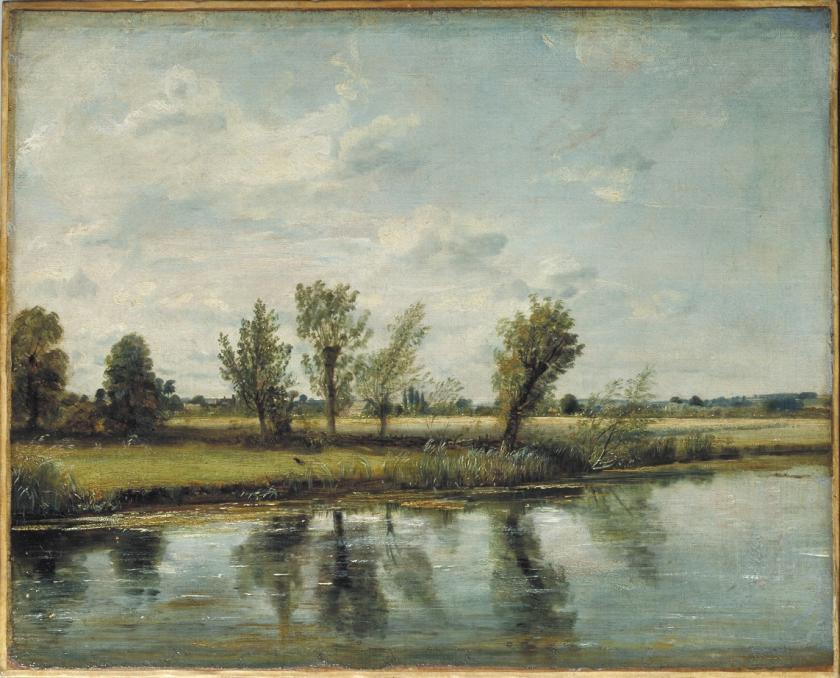This revelatory exhibition goes in search of the revolutionary magnificence which infused Constable’s compelling landscapes through an unusual prism. The narrative spine is clear. It follows Constable’s intense work playing upon as profound a knowledge of the Old Masters as was possible at the time, and reconciling it with, as he phrased it, the greatness of nature from which all originality must spring. We see nothing, he said, until we fully understand it.
Beyond looking to the acute observation of his own eye, Constable read energetically, too – treatises from Leonardo to Hogarth and Joshua Reynolds and many other influential exegeses on art by authors then popular and now known only to scholars.
Thus, amid a showing of Constable’s own work there is a fine sample of the prints and paintings he once owned – some 5,000 were sold after his death from his collections – and prints by and after Old Masters, and Old Master paintings he was able to see with his own eyes. There is a collection too of the copies he made after the artists he admired, some next to the originals, or we see an original with a quite different painting that it inspired.
As he phrased it, painting was but another word for feeling
A fascinating combination is Claude’s Hagar and the Angel, once in the rich connoisseur Sir George Beaumont’s collection (part of which came early to the National Gallery) and Constable’s Dedham Vale from the Coombs, also influenced by another Claude owned by Beaumont, Landscape with a Goatherd and Goats. He copied both of these Claudes as well. Beaumont was the acknowledged "leader of taste in the fashionable world”, its leading amateur painter and prescient collector, and he was a mentor to the young Constable. Another shows his copy of a Ruisdael, Winter Landscape, owned by Sir Robert Peel; Peel made Constable alter his copy – he added a dog – so that there would be no mistaking which was which.
Constable thought Rubens the finest landscape painter that ever lived, and here we see Rubens’s Landscape by Moonlight, 1635-40 (pictured below © Courtauld Gallery) alongside the Constable copy. He also admired with passion the English watercolourists – the short-lived Tom Girtin, for example, of whom Turner declared, “If poor Tom had lived, I would have starved.”
 His own work on view includes a variety of his small sketchbooks, a range of his intensely atmospheric small paintings, the size of a paintbox lid, including his famous cloud studies, and other studies and sketches and a selection of his famed six-footers – The Leaping Horse, The Hay Wain, Salisbury Cathedral.
His own work on view includes a variety of his small sketchbooks, a range of his intensely atmospheric small paintings, the size of a paintbox lid, including his famous cloud studies, and other studies and sketches and a selection of his famed six-footers – The Leaping Horse, The Hay Wain, Salisbury Cathedral.
As he phrased it, painting was but another word for feeling, and the profound attachment that the artist felt for the natural world – from Hampstead to Brighton, Dorset and above all, his beloved Suffolk – is indeed brilliantly revealed, based in part on the intimate oil sketches and sketchbooks (the V&A published some fine facsimile editions years ago) left to the museum by Constable’s last surviving child, Isabel, in 1888. And there is many a wonderful loan – Ruisdael’s magical The Jewish Cemetery from Dresden, for example, of which Constable owned two etchings. While he thought its symbolism too obscure, the actual composition directly affected his Salisbury Cathedral from the Meadows.
The result lifts the haze of complacency with which we tend to view Constable to reveal that he was hardly a slavish imitator of observed nature, although he sketched and painted obsessively outdoors – unlike Turner, who tended to work everything up in the studio from his colour notes and sketchbooks. The exhibition itself is arranged spacioiusly, with works glowing against deep pale blues, allowing the visitor room for ease of contrast and comparison.
- Constable: The Making of a Master at the Victoria & Albert Museum until 11 January
Overleaf: browse a gallery of images from the exhibition
Click on the thumbnails to enlarge









![SEX MONEY RACE RELIGION [2016] by Gilbert and George. Installation shot of Gilbert & George 21ST CENTURY PICTURES Hayward Gallery](/sites/default/files/styles/thumbnail_125_x_125_/public/mastimages/Gilbert%20%26%20George_%2021ST%20CENTURY%20PICTURES.%20SEX%20MONEY%20RACE%20RELIGION%20%5B2016%5D.%20Photo_%20Mark%20Blower.%20Courtesy%20of%20the%20Gilbert%20%26%20George%20and%20the%20Hayward%20Gallery._0.jpg?itok=3oW-Y84i)





Add comment